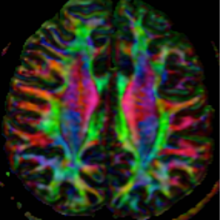
Dr. Pratik Mukherjee, Director of CIND, is one of five UCSF neuroscientist to receive one of NIH's first research grant to support President Obama’s BRAIN (Brain Research through Advancing Innovative Neurotechnologies) Initiative.
Project Narrative
If successful, the new technology developed in this project will dramatically improve our ability to visualize the structures and functions of human brain cortex. As a new research tool, it can not only transform the understanding of networks within our brain, but also provide potential high impact in the care of mental health, traumatic brain injuries, epilepsy among many other debilitating brain diseases and disorders.
Project Summary
MRI is the only technology that can image the connectivity of the human brain in vivo and non-invasively. However, neither BOLD fMRI nor diffusion-based fiber tracking has been able to break the barrier of 1-mm voxel spatial resolution. Yet, 1-mm voxel contains roughly 50,000 neuronal cells and the human cortex is less than 5 mm thick. The disparity between the spatial scales has thus created a large gap between MRI studies of the whole brain and optical imaging and cell recordings of groups of neurons. The overarching objective of this proposal is to bring noninvasive human brain imaging into the microscale resolution and begin to bridge studies of neuronal circuitry and network organization in the human brain. Our breakthrough technology, termed MR Corticography (MRCoG), will achieve dramatic gains in spatial and temporal resolutions by focusing exclusively to the cortex. Higher-sensitivity coil sensors will be designed that tailor to the superficial volume of the brain. MRCoG will also be used to map intracortical axonal connectivity, overcoming a fundamental resolution limit inherent to all in vivo human neuronal fiber tractography to date by replacing diffusion imaging with a novel susceptibility contrast mapping of axon fibers. Innovative imaging pulse sequences will be designed to complement the high-sensitivity coil arrays to achieve higher spatial resolution in the neocortex. The improved capabilities of these sensors will be further exploited using new, vastly more efficient spatial multiplexed and temporal multiplexed image acquisition to further accelerate scanning by taking advantage of spatiotemporal sparsity. In summary, the proposed research will create a novel technology for imaging the human brain’s neocortex with barrier-breaking resolution and contrast. MRCoG will facilitate the integration between in vivo non-invasive human-brain MRI and cellular and genetic imaging techniques. If successful, it will fundamentally transform our ability to study the human brain. Because it is based on MRI, MRCoG can be readily translated to patient care, providing potential high impact in the care of mental health, traumatic brain injuries, epilepsy among many other debilitating brain diseases and disorders.
Read more about it:
http://www.ucsf.edu/news/2014/10/118766/ucsf-neuroscientists-score-well-nih%E2%80%99s-first-brain-initiative-grants
